
- Home
- Art Movement
- Authenticity
- Genre
- Abstrait (59)
- Académisme (57)
- Art Déco (50)
- Barbizon (26)
- Baroque (84)
- Classicism (57)
- Classicisme (225)
- Expressionism (117)
- Expressionnisme (160)
- Fauvism (29)
- Fauvisme (53)
- Impressionism (134)
- Impressionnisme (497)
- Impressionniste (33)
- Orientalisme (74)
- Orientaliste (26)
- Realism (43)
- Renaissance (27)
- Romantisme (116)
- Réalisme (204)
- Other (2614)
- Theme
- Abstract (2)
- Animals (18)
- Architecture (5)
- Art (2)
- Character (48)
- Child (3)
- Flower, Tree (12)
- Genre Scene (30)
- History, War (3)
- Horse Portrait. (2)
- Hunting, Fishing (4)
- Landscape (232)
- Marine Landscape (2)
- Nude (2)
- Nude Woman (2)
- Portrait (7)
- Religion, Mythology (15)
- Seascape, Boat (38)
- Still Life (29)
- Other (4229)
- Thème
- Abstrait (39)
- Animaux (142)
- Architecture (15)
- Character (22)
- Chasse, Pêche (14)
- Enfant (30)
- Fleur, Arbre (40)
- Genre Scene (21)
- Histoire, Guerre (33)
- Landscape (71)
- Marine (35)
- Nature Morte (139)
- Paysage (809)
- Paysage ArborÉ (12)
- Personnage (191)
- Portrait (24)
- Religion, Mythologie (176)
- Scène De Genre (259)
- Seascape, Boat (14)
- Still Life (20)
- Other (2579)
- Type
Flemish School Circa 1580, Workshop Of The Master Of The Prodigal Son, Crossing The Red Sea
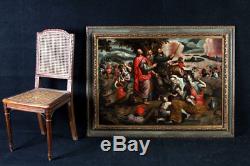
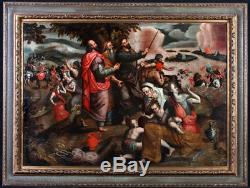

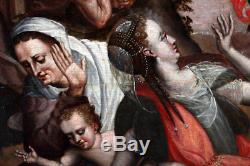
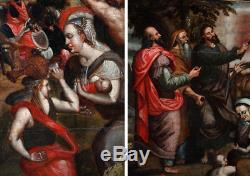

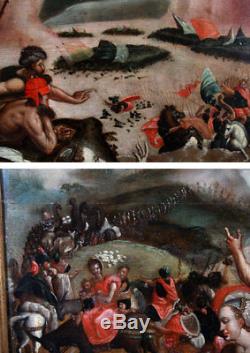
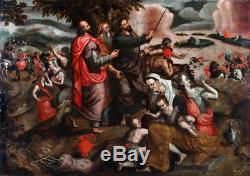
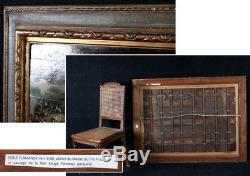


Flemish school around 1580, workshop of the master of the prodigal son 1530/1580. "the passage of the Red Sea". Period: Flemish school of the sixteenth.
Anonymous theme: religious, the passage of the Red Sea technique: oil on 4 panels of oak reinforced old restorations good condition format. With frame 128 x 97 cm without frame 100 x 76 cm. Recent carved wood good condition. Sold with invoice / certificate.
Table visible on avignon (france), free shipping for France. For abroad: shipping on request. This remarkable composition is part of a typically Flemish pictorial context, with a host of characters and details. This painting can be attributed to the master of the prodigal son, an Antwerp artist. We often designate artists whose identity we do not know, who realized a certain number of works grouped around a painting preserved in the kunsthistorisches museum in Vienna entitled the prodigal son among courtesans (successively attributed to mandijn, van palermo then kroes). His style is manifested by an influence of Roman painting and some borrowing from international mannerism. In this painting we find the same atmosphere as in the paintings of the master of the prodigal son, characters with large and exaggerated movements accentuated by an improbable length of limbs. The palette of colors is also characteristic of the works of the painter Antwerp.The master of the prodigal son essentially illustrated religious themes of the Old Testament and the New Testament. Some of his creations were mass produced, suggesting that he was at the head of a large workshop in the city of Danvers. Around this faceless artist and his assistants, the specialists gather about forty paintings that are found in several museums as well as in churches, in europe as well as in the United States (a virgin with the child is visible at cleveland museum). The art historians attribute to him the christ and the pilgrims of the museum of warsaw, satan sowing the tares of the museum of fine arts of Antwerp, a return of tobie of the museum of gand, a court of miracles in Royal Museum of Fine Arts in Brussels, the suzanne painting and the old men of the Port Museum.
Similarly, when we consult the Joconde database, the portal of the collections of the museums of France, we find under the name of the master of the prodigal son paintings in oil on wood as the virtue that rewards the work and punishes the laziness of the Chambéry museum, the wedding of cana of the Rouen museum, the virgin with the child with saint jean-baptiste of the museum of pau, the works of mercy of the museum of valenciennes, the old man in love with the musée du douai. The passage of the Red Sea.
Is a biblical and Koranic account that the sea blocking the passage of Israelites fleeing the Egyptian army, miraculously opens to let the Israelites pass and closes on their pursuers. The Hebrews are facing the Red Sea or Sea of Reeds when Egyptian troops pursue them. Moses holds out his hands towards the sea, whose waters split to leave a passage. The people are going down the hall. In their turn the Egyptians introduce themselves but Moses makes return the sea to its place engulfing the troops of the Pharaoh.This story is considered one of the founding events of Judaism, basing its faith in miraculous redemption by a personal god. It is traditionally read on the seventh day of Pesach. The exodus of the Red Sea is the ancient mythical tale of a divine war (conflict between the creator god and the primitive ocean, such as the Canaanite myth of Baal against yam), taken up by a priestly author who historicizes the myth by placing in the biblical context the deliverance of the Hebrew people from the Egyptians.
The item "Flemish school circa 1580, workshop of the master of the prodigal son, passage red sea" is on sale since Monday, November 5, 2018. It is in the category "art, antiquities \ art of the nineteenth and before \ paintings, enamels" The seller is "galerie-artableaux" and is located in avignon. This item can be shipped to the following countries: America, Europe, Asia.
- type: oil
- features: box
- artistic trend: Flemish school
- theme: religion, mythology

